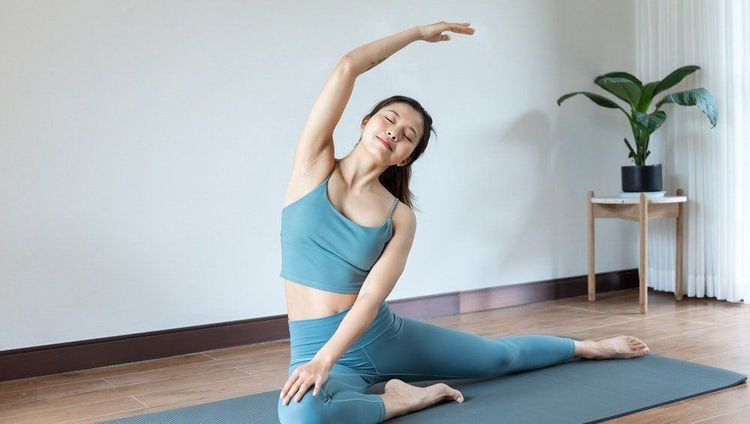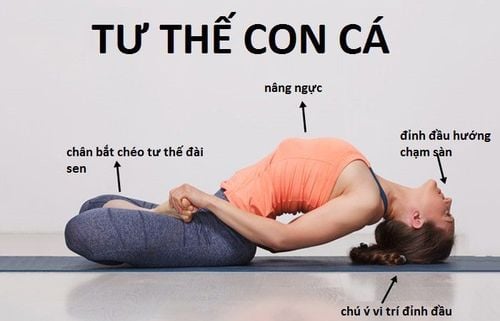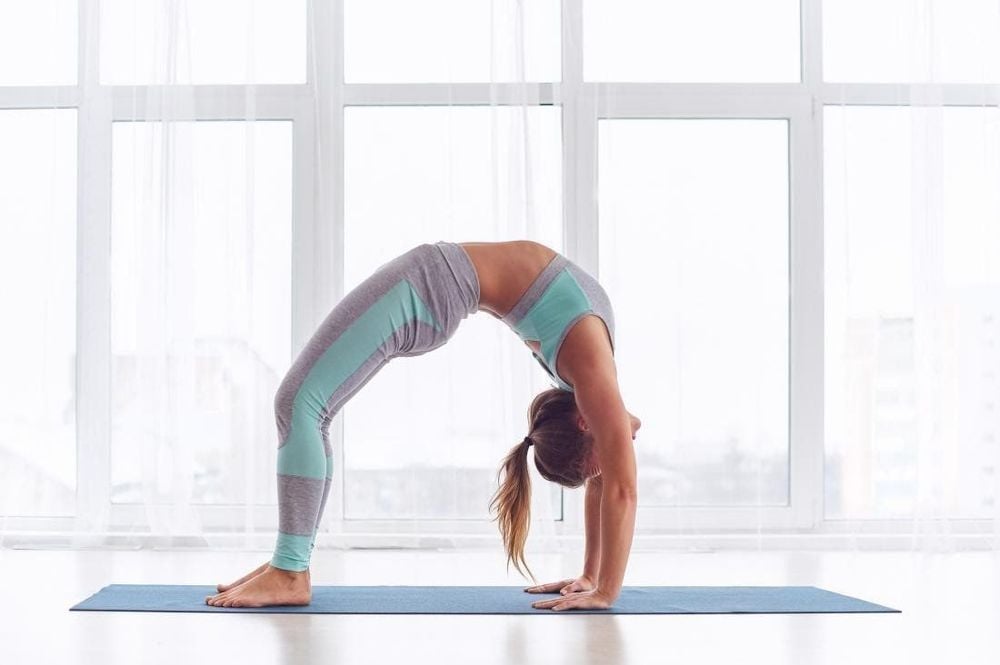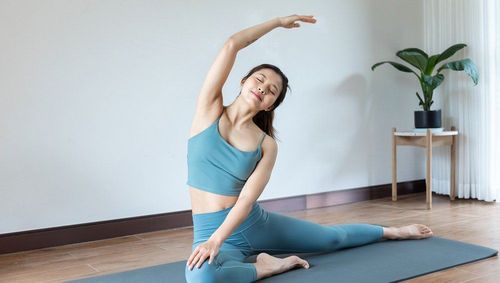This is an automatically translated article.
The article is medically reviewed by Dr. Debra Rose Wilson, Ph.D., MSN. IBCLC, AHN-BC, CHT- Written by Lana Burgess January 27, 2018.The article is translated by Master, Doctor Nguyen Thi Hang - Pathology Unit - Laboratory Department - Vinmec Times City International Hospital
When a person has a thyroid problem, it can affect both physical and mental health. This article aims to explore yoga as an adjunct therapy for thyroid problems.
1. Yoga and Thyroid Health
The thyroid is a small gland located in the neck that secretes hormones. These hormones affect metabolism, body temperature, and growth. They also affect the way a child's brain develops.Yoga is a practice that helps reduce one's stress level. A 2017 study found that yoga can help relieve thyroid symptoms and improve general health. In fact, stress is often associated with thyroid problems. For this reason, yoga can have many benefits for thyroid health.
There are many different conditions that affect the thyroid gland. 2 of the most common are:
Hyperthyroidism : This is a condition when the thyroid gland produces too much thyroid hormone. A potential cause of hyperthyroidism can be Graves' disease or an overactive thyroid. Hypothyroidism: This is a condition that occurs when the thyroid gland produces too little hormone. It is usually caused by autoimmune diseases that damage the thyroid gland. A small 2014 study found that yoga improves thyroid function. However, the study also shows that in-depth studies with more participants are needed to draw firm conclusions.
By 2016, another study was carried out, the results were that people who practiced yoga for 6 months had improved cholesterol levels and thyroid-stimulating hormone (TSH) levels, thereby reducing the need to need for hormone replacement therapy in hypothyroid women.
2. Benefits of choosing the right yoga poses
Good yoga poses for thyroid patients need to focus on stimulating the neck area. They are said to improve circulation, stretch and strengthen the site that contains the thyroid gland.When practicing, you need to keep the yoga posture so that you feel most comfortable. For beginners, you can try practicing with 1 or 2 poses and build on this position every time you practice.

2.1 Supported shoulder stand The shoulder stand involves an inversion, also known as an inversion in yoga. This inversion will help increase blood circulation to the throat area. Yoga researchers believe this will help stimulate the thyroid gland to develop better.
In Sanskrit, the shoulder stand is called Sarvangasana. To perform the shoulder stand, the practitioner should:
Lie on the back straight; Place a folded towel or blanket under your shoulders for support; Bring your shoulders to the edge of the towel while resting your head on the carpet; Place your arms by your sides with palms facing down; Press your arms and back firmly into the floor; Inhale and raise your legs at a right angle; Exhale and lift your legs, pushing up to your shoulders; Push your hands into your lower back to support your hips; The center allows the abdomen to be pulled in to strengthen the core; Keep your body and legs straight with your shoulders; Keep your chin tucked into your chest; Take 3 deep breaths; Slowly lower your legs down, keeping the center part aligned. 2.2. Plow Pose The Plow pose in yoga is also said to stimulate the thyroid gland. The Sanskrit name of this pose is Halasana.
To do the Plow, you should start in the same way as for the shoulder stand. However, instead of keeping your feet in a straight line from your shoulders, you should:
Bring your feet to the right and behind your head; Place your toes on the floor at the back of your head; Keep their lower back supported by their hands throughout the procedure; Take 3 deep breaths; Bring the legs back above the head; Slowly lower your legs back to the floor, keeping the center part aligned. The plow is a safe position, but it can be uncomfortable for overweight people or women with large breasts. Therefore, if you find it difficult to breathe while performing, slowly come out of the pose.
2.3 Fish Pose Fish Pose is a great pose to do after standing on the shoulder or plow, because it stretches the body in the opposite direction. In yoga, people call this the counter-pose. The Sanskrit name of this pose is Matsyasana.
To do Fish Pose, the practitioner should:
Sit down with your legs extended in front of you; Place your hands on the mat behind you with your fingers under your buttocks; Lower your elbows to the mat and drop back; Align shoulders with elbows; Gently drop your head back as it feels comfortable, with the end goal of reaching the top of your head on the mat; Keeping the chin straight and open, imagine a string pulling it up into the sky; Take three deep breaths; Slowly raise your head and release your arms out of position.

To perform the bridge pose, the practitioner should:
Lie on the mat with the back on the floor; pull the foot inward toward the hip; Keep feet and knees in line with hips; with the arms vertical on the sides of the body, press the palms of the hands to the floor; raise your hips to the sky, imagine a rope pulling your hips upwards; If this is difficult, place your palms on your lower back for support; Pull your chin into your chest; Take 3 deep breaths; Slowly lower hips to come out of position. 2.5 Cobra Pose The cobra pose gently stimulates the throat and thyroid area. The Sanskrit name of this pose is Bhujangasana.
To perform this pose, the practitioner should:
Lie face down on the mat; Place your palms on the mat below your shoulders; Squeeze elbows to sides; Press the palm of your hand into the carpet; Raise your head until your chest is off the mat and your back is arched; Drop your head downward if it feels comfortable; Take 3 deep breaths; Slowly lower your chest and head to the mat. 2.6 Boat Pose Boat Pose is great for strengthening the core, it also stimulates the throat area and is beneficial for the thyroid gland. The Sanskrit name of this pose is Navasana.
To do boat pose, one should:
Sit on the floor with legs stretched out in front; Place your hands on the mat, palms down, along the sides of your legs; lean back slowly, keeping your core strong, chin tucked in and back straight; Bend knees, lift feet off the floor; If possible, extend the legs and point the feet, so that the legs and body form a V shape; Raise the arms so that they are in line with the shoulders; palms should face each other, with fingers extended; Take 3 to 5 deep breaths; Bring your arms and legs down slowly, hugging your legs and dropping your head before releasing. 2.7 Wheel Pose (Upward Bow Pose)

To perform this pose, one should:
Lie on your back straight, bend your knees and bring them close to your body; Place your hands on the mat next to your head, making sure that your fingers are facing your shoulders and your elbows are facing up; Press your feet into the mat and exhale while lifting your tailbone and buttocks; Make sure inner thighs and feet are parallel; Press into the feet and hands and raise to the top of the head; Press deeper into the feet and hands while exhaling, then lift the head completely off the floor until the arms are straight out; Spread your shoulder blades and let your head hang loose; Hold the pose for 5-10 seconds while breathing deeply; Slowly release from the pose, flexing your arms and letting your tailbone and buttocks return to the mat. Supported Headstand Pose The Banana Pose is one of the most difficult yoga poses and has a direct impact on the thyroid gland. This pose helps blood flow to the heart as well as stimulates the pituitary and pineal glands of the brain, which can effectively reduce stress.
While very helpful, people should not try this pose without prior yoga experience and should be done under the supervision of an experienced teacher on the first attempt. The Sanskrit name for the banana tree pose is Sirshasana.
To perform the banana tree pose, the practitioner should:
Bend the knee forward so that the knee and forearm are on the mat; Interlock fingers with elbows shoulder-width apart and press inner wrists firmly into the mat; Place the crown of the head on the mat and gently push the back of the head up against the open palm; Lift your knees off the mat while inhaling; Bring your feet closer to your elbows and raise your heels to form an inverted V; Raise the shoulder blades upwards to elongate the torso and slightly stretch; Lift both feet off the mat at the same time while exhaling; it may be easier to bend the knee slightly during the ascent; Rotate upper thighs in while pushing heels toward ceiling, straightening knees; Make sure the weight is balanced between the forearms and continue to lift the shoulders upward; When the leg is fully extended, press upward through the big toe; Hold the pose for 5-10 seconds (can be increased by another 5 seconds each time the pose is repeated in the future); Slowly bring your feet back to the mat while exhaling, keeping your shoulders up until both feet touch the mat. In conclusion, certain yoga exercises can help improve thyroid health. However, for beginners, it is advisable to practice under the guidance of teachers and experienced people to ensure no injury and get the opposite effect.
Please dial HOTLINE for more information or register for an appointment HERE. Download MyVinmec app to make appointments faster and to manage your bookings easily.
Reference source: medicalnewstoday.com













